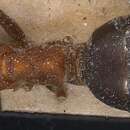Biology
provided by Arkive
Wood ants are carnivorous, and workers carry a wide variety of prey back to the nest along well-defined trails that extend throughout the territory (4). Food taken to the nest is destined for the brood, the workers suck sugary sap from plants and also tend aphids for the sugary 'honey dew', which they exude from the anus (4).
All wood ant nests are constructed in a way that maximises the amount of sunlight falling onto the mound. Due to the heat produced by the workers and the thatching (which helps to conserve heat) the nests are warmer than the surrounding soil (4). At the beginning of spring each year, special eggs are produced; unfertilised eggs develop into males and the eggs that become queens are fed more than those that are destined to become workers. During June, usually on a warm humid day, huge numbers of winged reproductive males and females leave the nest and engage in a mating flight. After mating the male soon dies, the queen sheds her wings, and a new colony is established (4). Occasionally the queen may 'take-over' a southern wood ant (Formica rufa) colony, by killing the resident queen and slowly building up a colony of F. lugubris while the host workers die (4).
Conservation
provided by Arkive
A Species Action Plan has been produced to guide the conservation of this species in the UK under the auspices of the UK Biodiversity Action Plan. This plan aims to maintain the current range of the hairy wood ant (3). Some populations occur within Sites of Special Scientific Interest (SSSIs) and National Nature Reserves (NNRs) (3).
Description
provided by Arkive
The hairy wood ant can be distinguished from the other wood ants by the possession of a fringe of hairs that reaches down to the eyes (4). It is also more northern in its UK distribution (5). The wood ants are the largest of the British ants, all of which are reddish in colour and have a single segment forming the 'waist' (4). Reproductive females (queens) and males are larger than the workers, and have well-developed thoraxes and wings (which separate from the body after mating). Males have obvious sex organs that protrude from the abdomen (4).
Habitat
provided by Arkive
The impressive mound-nests are constructed in sunny locations on the edges of woodland rides and glades (5), and at the edges of scrub (5).
Range
provided by Arkive
In the UK, this species has a range that reaches from the Scottish Highlands, and upland parts of the north of England to mid-Wales (3). Elsewhere it is known from the northern Palaearctic region and mountainous parts of central and southern Europe and Asia (3).
Status
provided by Arkive
Classified as Local in Great Britain (3) and listed in the IUCN Red List as Lower Risk, near threatened (LR/nt) (1).
Threats
provided by Arkive
This ant has been affected by habitat loss caused by urban and industrial development, agricultural intensification and forestry (3). In remaining woodlands, a move away from traditional management practices, and new stocking regimes have often caused scrub invasion which results in a decrease in the sunny rides or clearings favoured by this ant (3).

